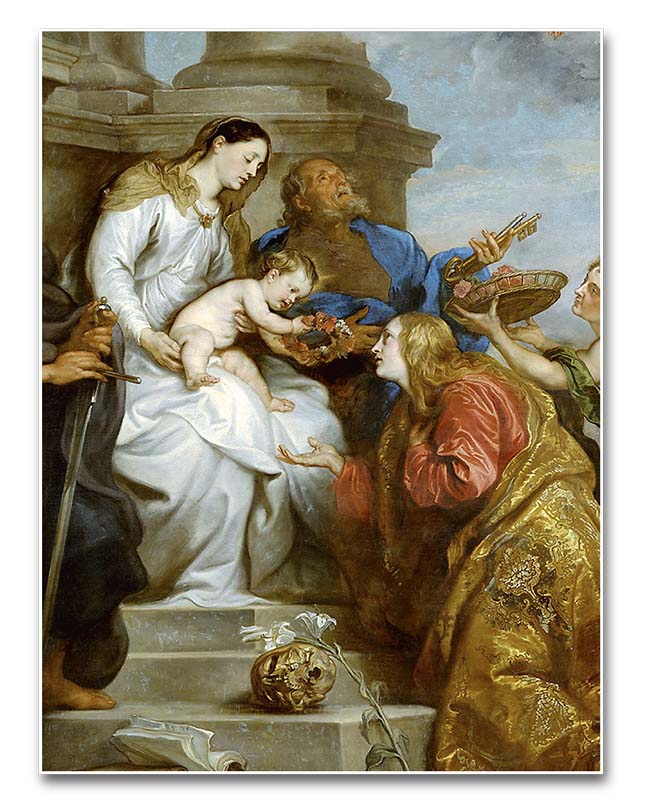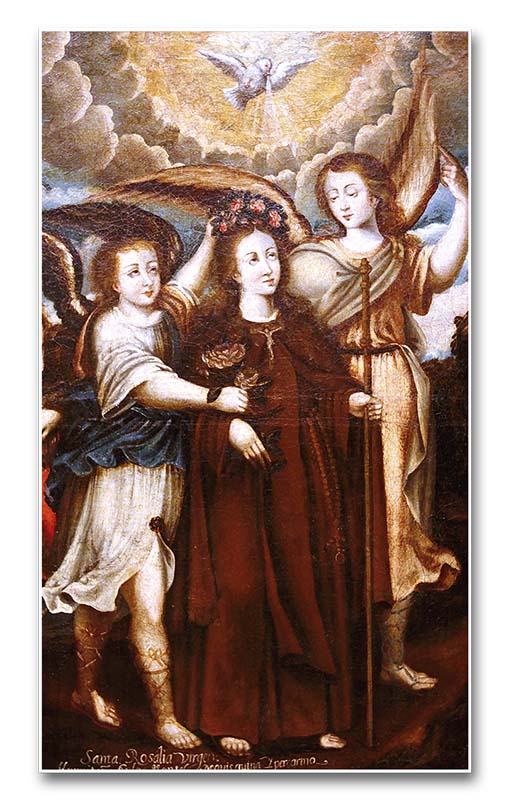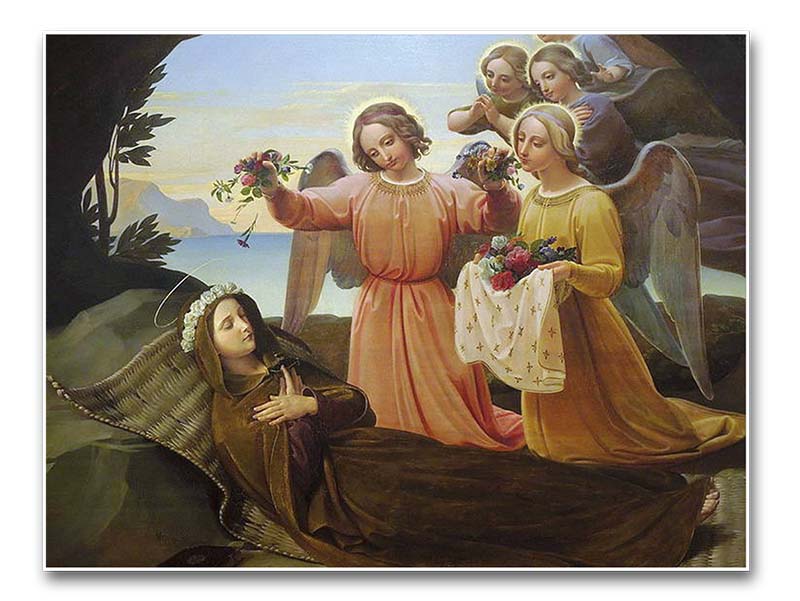She abandoned the palace in which she was born to live as a hermit in dark and humid caves. There she found trial and suffering, but also supernatural light, and regular, intimate contact with Jesus, Mary and the Angels.
“I, Rosalia, daughter of Sinibald, Lord of Quisquina delle Rosa, have taken the resolution to live in this cave for love of my Lord Jesus Christ.” These are the words etched on the rock of a gloomy cavern by the hands of a young princess who left the luxury of her palace and chose to hide in the mountains to give herself entirely to her sole Beloved.
The story of this angelic hermit, little known outside of Italy, is one of the most beautiful examples of the fulfilment of the Redeemer’s promise to those who leave home, father, mother or land for His name (cf. Mt 19:29). She received a hundredfold in heavenly favours, even on this earth, and glory in eternity. Let us, then, take a brief look at her life.1
Ardent love for Jesus from her infancy
Rosalia was the daughter of the Duke Sinibald, whose fief extended across the Province of Palermo and Agrigento. This noble descendant of Emperor Charlemagne enjoyed the esteem of the King of Sicily, Roger II. Her mother was a close relative of the monarch.
This sweet girl was born in 1130, in what is today the city of Palermo. The name chosen by her parents is a contraction of the Latin words rosa and lilia – rose and lilies –, flowers that symbolize royalty and purity respectively. Thus, her very name foretold the two virtues that would distinguish her.
Her parents gave her an excellent education in keeping with her high birth. Although she was surrounded by luxury, worldliness and the comforts of the court, Providence inspired in her from a tender age an ardent and exclusive love for Our Lord Jesus Christ and the desire to belong entirely to Him.
The years passed, and her parents planned to marry her to a noble suitor, chosen from among the many who vied for her hand. However, the Blessed Virgin guarded the purity of this maiden in a special way, one day appearing to her to invite her to abandon the world to follow her Divine Son.
Filled with joy, Rosalia prepared to leave immediately. The only provisions she took with her were some spiritual books, instruments of discipline, a crucifix and a chaplet of beads.

Young hermit in a dark and humid cave
Rosalia was only fourteen years old when she definitively left her family’s palace. Tradition tells us that she was guided by “two Angels, one in knight’s armour and the other dressed as a pilgrim.”2 They guided her to Mount Quisquina, located sixty kilometres from Palermo, where they showed her the cavern where she should take up her abode.
An extremely narrow and low opening gave access to it. Inside, it was dark and humid, due to the constant dripping of water, and was divided into small compartments connected by cramped passageways. The small well she dug to gather the water that seeped through the stone walls can still be seen today. There is also a rustic altar and a long smooth rock which she used as a bed. In this remote cave, covered with dense vegetation and hidden within the rock face, Rosalia could live in absolute solitude.
What transpired over the years the virginal hermit spent there is described by contemporary hagiographers: “Immersed in constant prayer, she suffered the attacks of the common enemy who sought to turn her away from her holy resolution, but he was continually vanquished by her. She received visits and communications from the Angels, by which the Lord rewarded the heroism of her resolution.”3
Some authors allege that the rest of her story is lost in the mists of time, dismissing the possibility of knowing with certainty subsequent details of her life. But let us fortify our faith and embark on the path that unites the supernatural and the legendary by the pen of one of St. Rosalia’s oldest biographers, the Franciscan Juan de San Bernardo. What follows is a selection of pious episodes that he relates.
Heavenly company… and unceasing battles
At the outset, Rosalia’s new life in Quisquina was pervaded with consolation. Appalling privations and harsh mortifications seemed sweet to her. She ate herbs, roots and wild fruit collected in the nearby woods and bore the rigours of exposure to inclement weather. She lived hidden to men, but known to God, His Blessed Mother, and His Angels and Saints, who visited her frequently and kept her company. Attentive to angelic instructions and teachings, she divided her time between prayer, penance, manual labour and, above all, colloquies with her beloved Jesus.
After almost one year had passed, the Lord deigned that the trials would begin, allowing the devil to violently attack her. It is a common phenomenon in the spiritual life that the luminous morning of consolation gives way to a dark and stormy night… But it is God who, in His infinite wisdom, chooses these moments to test His chosen ones, tempering their souls like swords in the forge, so as to grant them a more resplendent crown of greater glory.
Rosalia suffered severe headaches and stomach pains, along with sensations of cold and heat so intense that they seemed to reach her very bones. The devil reminded her of the comforts of the palace she had abandoned and suggested to her that what she had done was sheer madness, and that she would be unable to endure the sufferings that such a life entailed. He subjected her to profound sadness and melancholy, which made the practice of her spiritual exercises wearisome. It was with these battles in mind that her Angel inspired her to engrave in the rock at the entrance of the grotto the reason she had chosen to live there.

A series of terrible trials
Temptations against purity were among the most difficult trials she had to confront. The devil subtly entered her imagination, producing vile scenes and wicked thoughts. The young lady, who had never experienced such impulses, suffered horribly as a result. Such was the intensity of the trial that she feared that she was about to succumb. She armed herself with prayer and mortification, and implored divine help amid tears. Her cries were heard, and the adversary was defeated.
The infernal enemy then turned to another form of attack, assuming visible form and seeking to cause her perdition in a variety of ways. He appeared to her as an elegant young man, with the goal of conquering her heart and turning her away from the love of Christ. But the virgin was once again victorious, for, with crucifix in hand, she implored the aid of her Redeemer.
On one occasion, the devils assumed the aspect of courtesans and among them was a gentleman who served her father. They introduced themselves as being sent by Sinibald, kindly telling her that they had come to bring her back to court, where her parents awaited her with great anxiety. For Rosalia this was one of the greatest trials, not because she felt inclined to return, but because of the horror that this idea caused her. Almost sapped of strength, she could only turn her eyes to Heaven, in silent supplication… Christ crucified then appeared to her, and His light and splendour scattered the darkness of the evil one. Our Lord exhorted her to perseverance amid suffering and, beckoning her, He pressed her to His divine bosom.
With these trials vanquished, Rosalia emerged from the combat fortified and the temptations became easier to endure. Nevertheless, seeing that he could not inflict his horrible seal upon that pure and innocent soul, the enemy sought to torment her physically. When she was attacked with such violence that she was left unable care for herself, the Angels took on visible form to care for, console and serve her. On these occasions, they prepared food for her and applied remedies. On one occasion, the Blessed Virgin herself came to help her and keep her company.
Three feasts commemorated with Jesus and Mary
Through everything, she maintained her routine of prayer and recollection. She meditated on the mysteries of the life of Our Lord, in accord with the seasons in which they are celebrated by the Church, and received from God a clear understanding in their regard. She was accustomed to praying or singing the Office of Our Lady, accompanied and helped by her Guardian Angel whenever she was weakened or ill.
She commemorated the main solemnities with great fervour and all the exterior worship she could. She was particularly devoted to three feasts – Christmas, Easter and the Assumption of the Blessed Virgin Mary. On these days, Jesus Himself, Supreme and Eternal Priest, celebrated Mass in the cave, assisted by St. Peter, who gave the sermon. The Angels provided ceremonial embellishment and music, while the Queen of Heaven participated in the celebration beside Rosalia. On Christmas Eve, She granted her a special gift: She gave her the Child Jesus to hold in her arms! On the day after these three feasts, the commemorations continued with a splendid banquet prepared by the Angels.
Transferred to Mount Pellegrino
After some years, the Lord bid the young anchorite to relocate. Some sources say that the reason for this transfer was that she would be discovered if she remained in Quisquina, since her family was still searching for her. Others believe that the inhabitants of the neighbouring regions, having learned that a Saint lived on that mountain, were flocking to her in great numbers to request her prayers. Thus, once again escorted by an angelic detachment, she left her beloved sanctuary.

The Angels led her towards Palermo and, after a long journey, she reached Mount Pellegrino. Of imposing elevation and, at that time, difficult to access, its peak was exposed to the strong north wind. The grotto chosen, set amid high cliffs, never saw the light of the sun and water dripped unceasingly. “All of these conditions necessarily created the state of a perpetual and very harsh winter inside grotto.”4 Her new habitation, darker, more austere and inhospitable than the previous one, pleased her greatly.
It was in this place that Rosalia spent the last years of her earthly life. After eighteen years of a solitary and austere life, she surrendered her beautiful soul to God on September 4, 1160.
Glorification “post mortem”
There is good reason to suppose that the inhabitants of the neighbouring cities and farms were aware that a virtuous hermit lived in the cave of Mount Pellegrino and of Quisquina. If not, it would be hard to explain how devotion to her spread so quickly: “The people of Palermo immediately honoured her as a Saint, and starting at the end of the twelfth century many churches and chapels were dedicated to her in Sicily and in southern Italy.”5 However, her body was not found.
The centuries passed and, in 1624, Palermo was ravaged by an epidemic that claimed thousands of victims. This was the occasion chosen by St. Rosalia to appear in a dream to a certain lady, to whom she indicated with great precision the location of the cave of Mount Pellegrino where her body lay. After arduous and persistent excavations, a large alabaster stone was found on July 15, inside of which the precious treasure was found. This tomb could only have been prepared by Angels. Together with her bones, were “a crucifix of terracotta, a Greek silver cross and some of the beads on which she had prayed”6 the Marian psalter.
The relics were transported to the chapel of the Archbishop of Palermo, Cardinal Giannettino Doria, who ordered an investigation to verify their authenticity. Meanwhile, many sick persons were cured of the ongoing epidemic by invoking St. Rosalia. When the process ended, in June of 1625, the relics of the Santuzza – as she is affectionately called by the Palmeritani – were carried in solemn procession throughout the city and the plague suddenly ended.
In 1630, Pope Urban VIII inscribed her in the Roman Martyrology, with two feasts: on July 15, in commemoration of the discovery of her relics, and on September 4, her dies natalis.

* * *
What stands out when analysing St. Rosalia’s life is the radicalness with which she corresponded to each invitation of grace. The relationship with the supernatural dominated her entire being, relegating material things to a secondary plane. This is how truly Catholic souls follow their vocation!
And if today’s world seems to have forgotten the heavenly reality – the highest and most authentic of all realities – is it not because it has sinfully turned to what is vain and fleeting?
“We were created for the same end as the Angels; like them, we were raised to the supernatural order; and, in that eternity in face of which earthly life is a mere instant, we will participate in the spiritual society of the Angels, contemplating, loving, praising and serving God. […] This purpose is just as real in earthly life as it is in Heaven.”7
May St. Rosalia help us, so that by her example and intercession, “already here on earth” we participate “in the blessed company of Angels and men united in God.”8 ◊
Notas







